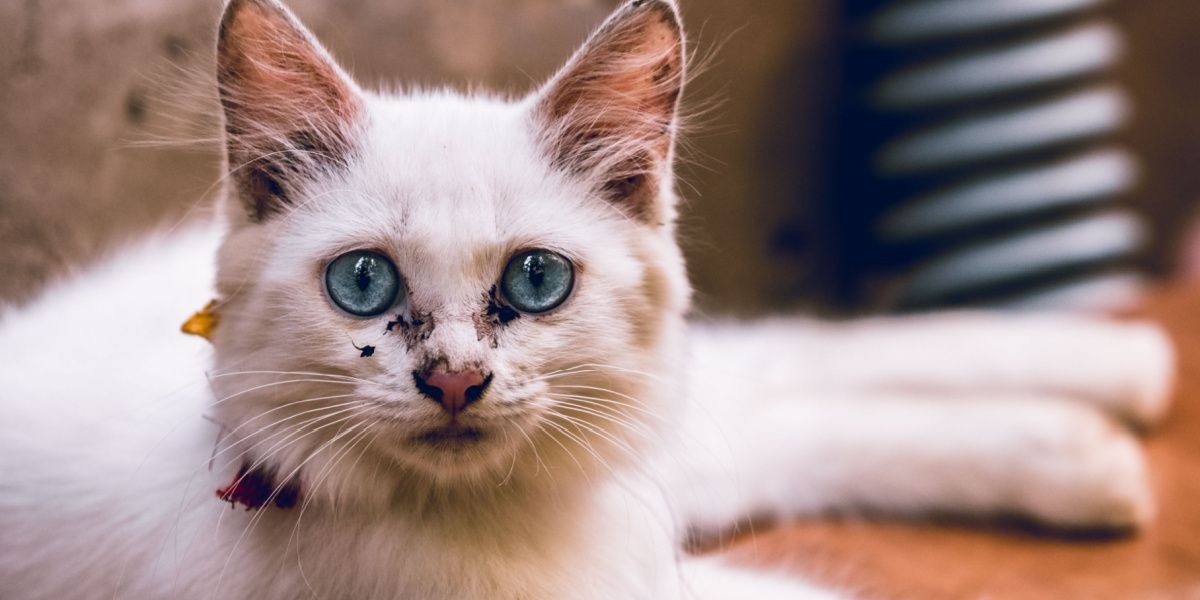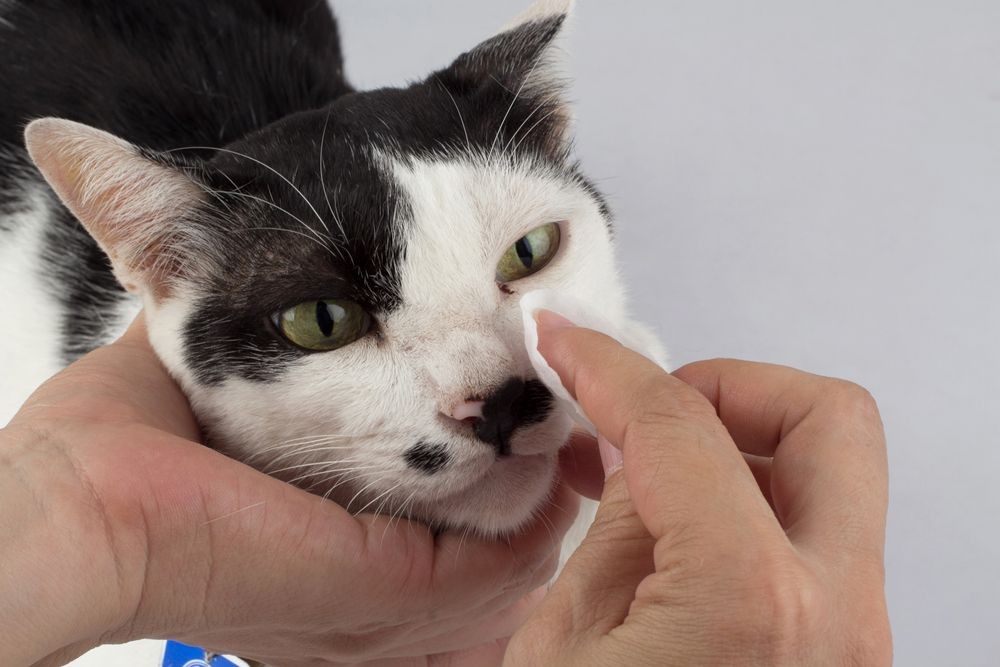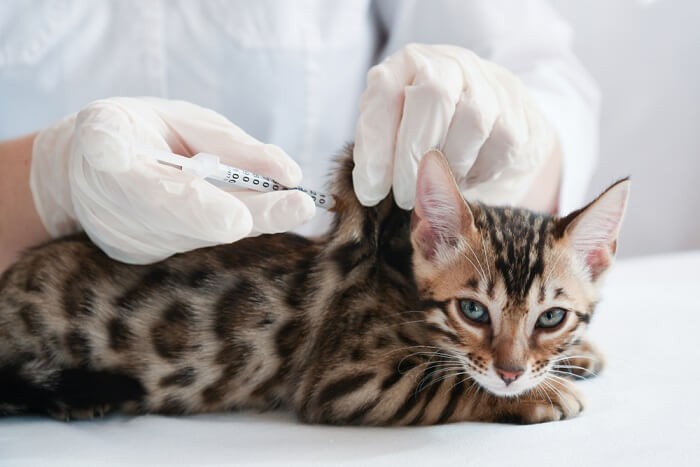Is your feline friend sporting those crusty eye secretions? This article, crafted by the experts at WHY.EDU.VN, dives deep into why cats get eye boogers, explaining what’s normal and when to worry. Discover expert tips for cleaning and prevention, ensuring your cat’s eyes stay healthy and bright. Plus, learn about potential health issues signaled by unusual discharge, including potential tear duct blockages, allergies, and eye infections.
1. What Are Cat Eye Boogers?
Just like us, cats accumulate secretions in the corners of their eyes, often called “eye boogers,” “eye goop,” or simply “sleep.” These are a mixture of mucus, dried tears, and debris that collect throughout the day and especially during sleep.
Cats’ eyes are protected by a tear film containing water, salts, proteins, mucus, and fatty oils. This film washes away dirt, dust, foreign materials, chemicals, viruses, and bacteria. When a cat blinks, the tear film spreads across the eye. The tears either drain through tear ducts or evaporate. During sleep, components like mucus can settle in the corners of the eyes, forming eye boogers.
2. Are Eye Boogers Normal in Cats?
A healthy cat’s eyes should be clear and bright. Small amounts of eye boogers, particularly after sleeping, are generally normal. The appearance can vary – some are sticky and moist, while others are dark and crusty.
Certain breeds, like Persians and Himalayans, are more prone to eye boogers due to their facial structure. Their flatter faces and large eyes can lead to inadequate tear drainage. However, consult your veterinarian to ensure the amount is normal for your cat, as these breeds are also susceptible to other eye conditions.
3. How to Clean Your Cat’s Eye Boogers
If your cat is prone to eye boogers, you can safely clean them away with these simple steps:
- Boil and Cool Water: Boil water and let it cool to lukewarm.
- Wash Hands: Wash your hands thoroughly with soap and water.
- Dip Cotton Ball: Dip a cotton ball into the cooled, boiled water.
- Gently Wipe: Gently wipe away the discharge from the inner corner of the eye outwards.
- Follow Fur Grain: Wipe in the direction of the fur growth.
- Fresh Cotton Ball: Use a fresh cotton ball for the other eye to prevent cross-contamination.
Alternatively, you can use pet-safe eye wipes designed for cleaning around your cat’s delicate eye area.
3.1. Cleaning Supplies Checklist
| Item | Description |
|---|---|
| Cotton Balls | Soft and gentle for cleaning delicate areas around the eyes. |
| Pre-boiled Water | Clean and cooled to prevent any contamination. |
| Pet Eye Wipes | Pre-moistened wipes specifically designed for cleaning pets’ eyes. |
| Soft Towel | To gently dry the area around the eyes after cleaning. |
| Treats/Positive Reinforcement | Reward your cat after cleaning to create a positive association. |



3.2. Step-by-Step Guide to Cleaning
- Prepare Your Supplies: Gather your cotton balls, pre-boiled water, and any treats to reward your cat.
- Approach Calmly: Approach your cat in a calm and soothing manner.
- Wet the Cotton Ball: Dip the cotton ball into the pre-boiled water, ensuring it’s damp but not dripping.
- Gently Wipe: Gently wipe from the inner corner of the eye outwards, following the natural direction of the fur.
- Use a Fresh Cotton Ball for Each Eye: To prevent spreading any potential infection, use a fresh cotton ball for the other eye.
- Dry the Area: Use a soft towel to gently dry the area around the eyes.
- Reward Your Cat: Give your cat a treat and praise to reinforce positive behavior during the cleaning process.
4. When Are Eye Boogers a Cause for Concern?
While small amounts of eye boogers are normal, changes in quantity, color, or consistency can indicate a more serious problem. Contact your veterinarian immediately if you notice any of the following:
- Increased Discharge: A significant increase in the amount of eye boogers.
- Color Change: Yellow, green, or bloody discharge.
- Consistency Change: Thick, pus-like discharge.
- Additional Symptoms: Pawing at the eyes, excessive blinking, redness, squinting, or swelling.
These symptoms could be related to conditions like:
- Foreign Bodies: Objects like grass awns lodged in the eye.
- Excessive Tearing: Caused by blocked tear ducts or allergies (e.g., pollen).
- Feline Upper Respiratory Infections: Viruses (feline herpesvirus, feline calicivirus), bacteria, or protozoa.
- Eyelid Abnormalities: Entropion (eyelids folding inwards).
- Conjunctivitis: Inflammation of the pink lining around the eyes, caused by bacterial or viral infections.
- Corneal Ulcers: Painful ulcers caused by trauma or viral infections.
- Uveitis: Inflammation of the internal eye structures, often with excessive discharge, caused by trauma, infections, or cancer.
4.1. Types of Abnormal Eye Discharge
| Type of Discharge | Potential Cause | Additional Symptoms |
|---|---|---|
| Watery | Allergies, blocked tear ducts, foreign body | Excessive tearing, redness |
| Mucus-like | Viral or bacterial infection, conjunctivitis | Sneezing, coughing, nasal discharge |
| Pus-like | Bacterial infection, corneal ulcer | Redness, swelling, pain, squinting |
| Bloody | Trauma, severe infection, uveitis | Pain, sensitivity to light, vision changes |
| Dark Brown/Black | Debris accumulation, chronic inflammation | Irritation, scratching |
4.2. Common Eye Conditions in Cats
| Condition | Description | Symptoms |
|---|---|---|
| Conjunctivitis | Inflammation of the conjunctiva, the membrane lining the inner eyelids and covering the white part of the eye. | Redness, swelling, discharge (clear, yellow, or green), excessive blinking |
| Corneal Ulcer | An open sore on the cornea, the clear front surface of the eye. | Pain, squinting, excessive tearing, cloudiness of the cornea |
| Uveitis | Inflammation of the uvea, the middle layer of the eye that includes the iris, ciliary body, and choroid. | Redness, pain, sensitivity to light, cloudiness of the eye, change in pupil size, vision loss |
| Glaucoma | Increased pressure inside the eye, which can damage the optic nerve. | Enlarged eye, cloudiness of the cornea, dilated pupil, vision loss |
| Cataracts | Clouding of the lens of the eye, which can impair vision. | Gradual clouding of the lens, decreased vision |
| Entropion | Inward rolling of the eyelid, causing the eyelashes to rub against the cornea. | Squinting, excessive tearing, redness, corneal irritation |
| Cherry Eye | Prolapse of the gland of the third eyelid, causing a red mass to protrude from the inner corner of the eye. | Red mass protruding from the inner corner of the eye, discharge |
5. When to Call Your Cat’s Veterinarian
Contact your veterinarian if you notice any change in your cat’s eyes or eye boogers. Seek urgent veterinary advice if your cat exhibits the following symptoms:
- Squinting or holding eye(s) shut.
- Red, inflamed eye(s).
- Swollen eye(s).
- Pus-like eye discharge.
- Cloudiness of the corneas.
- Vision trouble.
- Trouble breathing.
- Poor appetite.
- Lethargy.
- Fever.
Early detection and treatment are crucial for maintaining your cat’s eye health.
6. Prevention of Eye Boogers in Cats
While you can’t prevent normal eye boogers, you can take steps to minimize excessive discharge:
- Regular Vet Checks: Routine health checks with your veterinarian.
- Vaccinations: Vaccinations against contagious respiratory diseases, such as feline herpesvirus.
- Underlying Cause Diagnosis: If your cat has excessive eye boogers, get a diagnosis from your veterinarian to address the underlying cause. Treatment may range from simple eye drops for an infection to further testing for conditions like feline infectious peritonitis (FIP).
7. Expert Insights on Feline Eye Health
According to Dr. Emily Carter, a veterinary ophthalmologist, “Maintaining proper hygiene and regular check-ups can significantly reduce the risk of eye infections and related issues in cats. Early intervention is key to preventing long-term damage and ensuring your cat’s comfort.” This underscores the importance of proactive care and timely veterinary consultations.
8. What Research Says About Cat Eye Health
A study published in the Journal of Feline Medicine and Surgery found that regular cleaning of the eyes in predisposed breeds like Persians can reduce the incidence of chronic eye irritation by up to 30%. This highlights the benefits of consistent and gentle eye care for cats prone to eye boogers.
9. Keeping Your Cat’s Eyes Healthy: A Comprehensive Guide
| Aspect | Details | Benefits |
|---|---|---|
| Regular Cleaning | Gentle cleaning with a damp cotton ball or pet-safe eye wipes. | Prevents debris accumulation, reduces risk of infection. |
| Proper Diet | Balanced nutrition to support overall health and immune function. | Strengthens immune system, helps fight off infections. |
| Vaccination | Regular vaccinations to protect against common viral infections like feline herpesvirus. | Prevents viral infections that can cause eye issues. |
| Environmental Control | Minimizing dust, allergens, and irritants in the environment. | Reduces allergic reactions and irritation. |
| Regular Vet Checks | Annual or bi-annual check-ups to monitor eye health and detect any underlying issues early. | Early detection of eye problems, timely intervention. |
| Avoid Irritants | Avoid using harsh chemicals or cleaning products near your cat’s eyes. | Prevents chemical irritation and damage. |
| Monitor Changes | Regularly observe your cat’s eyes for any changes in appearance, discharge, or behavior. | Early detection of potential problems. |
| Hydration | Ensure your cat stays well-hydrated to maintain proper tear production. | Helps keep eyes lubricated and healthy. |
10. FAQ About Cat Eye Boogers
10.1. Is it normal for my cat to have eye boogers every day?
A small amount of eye boogers is normal in healthy cats, representing mucus and debris from the tear film. If the amount seems excessive or your cat shows signs of ocular irritation, consult your veterinarian.
10.2. Should I clean my cat’s eye boogers?
Most cats with tiny amounts of normal eye boogers don’t need cleaning. However, breeds like Persians, prone to eye boogers, benefit from daily cleaning to keep the eyes and skin healthy.
10.3. Should I take my cat to the vet for eye boogers?
Always consult your veterinarian if you have concerns about your cat’s eyes. While a small amount of eye boogers is normal, changes in amount, color, or consistency warrant a vet visit. Seek immediate attention for painful, swollen, inflamed, or red eyes, or if your cat has symptoms like sneezing, poor appetite, diarrhea, or lethargy.
10.4. Can diet affect my cat’s eye health?
Yes, a balanced diet rich in essential nutrients can support overall eye health. Ensure your cat is getting enough vitamins and antioxidants through their food.
10.5. How often should I clean my cat’s eyes?
If your cat is prone to eye boogers, daily cleaning is recommended. Otherwise, monitor their eyes and clean as needed.
10.6. Can allergies cause eye boogers in cats?
Yes, allergies can cause increased tear production and subsequent eye boogers. Consult your vet to identify and manage any allergies.
10.7. Is there a link between eye boogers and upper respiratory infections in cats?
Yes, upper respiratory infections often cause increased eye discharge. If your cat has other symptoms like sneezing or nasal discharge, consult your vet.
10.8. How can I tell if my cat is in pain due to an eye problem?
Signs of pain include squinting, excessive blinking, pawing at the eye, and changes in behavior. If you notice these, consult your vet immediately.
10.9. Are some cat breeds more prone to eye problems?
Yes, breeds like Persians and Himalayans are more prone due to their facial structure. Regular check-ups and cleaning are essential for these breeds.
10.10. Can I use human eye drops for my cat?
No, never use human eye drops for your cat without consulting your vet. Some ingredients can be harmful.
11. Conclusion: Ensuring Your Cat’s Eye Health
Cats, like their owners, are prone to small amounts of mucus-like secretions at the corner of their eyes, known as eye boogers, sleep, or eye gunk. Certain breeds such as Persians are more likely to have noticeable amounts of eye boogers due to their face and eye anatomy, which require regular gentle cleaning by their owners. A change in the amount or type of eye boogers or eye discharge should always be checked out by your veterinarian as it may indicate a serious eye condition.
Do you have more questions about your cat’s health? Need expert advice tailored to your feline friend? Visit WHY.EDU.VN. At WHY.EDU.VN, we understand that finding reliable answers to your questions can be challenging. Our platform connects you with experts who provide accurate, easy-to-understand information on a wide range of topics. We are committed to offering clear, trustworthy answers. At WHY.EDU.VN, we make expertise accessible, ensuring you receive the reliable answers you deserve. Contact us at 101 Curiosity Lane, Answer Town, CA 90210, United States, or via WhatsApp at +1 (213) 555-0101. Visit our website at why.edu.vn for more information.
